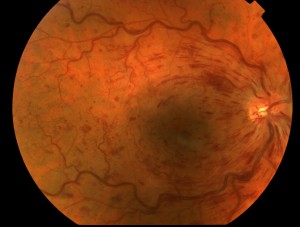Central Retinal Vein Occlusion
What Is Central Retinal Vein Occlusion?
 Arteries carry blood from the heart to various body parts, and veins return it. The retina has one major artery and one major vein, which is called the central retinal vein. Sometimes this vein can be blocked. This is called central retinal vein occlusion.
Arteries carry blood from the heart to various body parts, and veins return it. The retina has one major artery and one major vein, which is called the central retinal vein. Sometimes this vein can be blocked. This is called central retinal vein occlusion.
What Causes Central Retinal Vein Occlusion?
In most cases, an underlying cause is not found and we never know why it happens. It is more common in patients with glaucoma, high blood pressure, arteriosclerosis, and diabetes than it is in other people.
Why Does It Cause Decreased Vision?
When the vein is blocked, the circulation is greatly slowed. There is often some degree of fluid back-up and swelling of the center of the retina (macula). When this happens, the retina doesn’t function well, and the vision becomes blurred.
What Is Likely To Be The Visual Outcome?
A few patients, with time, have a spontaneous improvement in vision. Some patients get worse. The ultimate visual outcome cannot be predicted for anyone. In general, the more severe the occlusion, the less likely the vision will improve spontaneously.
What Can Be Done To Improve Vision?
Laser, eye drops, and glasses do not help to improve vision. There are some medicines that can be injected into the eye to help reduce macular edema and improve vision in some patients to some degree.
Why Are Follow-up Visits Necessary?
Patients need to be seen at regular intervals because in about one-third of all cases, a severe form of glaucoma called neovascular glaucoma develops. The warning signs of this glaucoma usually do not cause symptoms and an exam is needed to identify these signs. If it looks like this is about to occur, a laser treatment is necessary. In most cases, the laser can prevent the glaucoma. The laser does not improve the vision.
Are There Any Restrictions Or Precautions?
There is no reason to limit one’s activities, to avoid reading, to avoid watching TV, etc. However, when one has blurred vision in one eye for any reason, one’s depth perception is hampered. To the degree that this is true, one should be very careful doing anything which requires the ability to judge distances such as working around machinery, climbing on ladders and scaffolds, pounding nails, pouring hot liquids, and driving. It is relatively uncommon for a similar process to affect the other eye, and blurry vision in one eye does not in any way harm the “good eye”.
When Should a Patient Come Back Before Their Appointment?
A patient should come back sooner than scheduled if there is a marked decrease in vision or if the eye becomes painful.
If you have additional questions or concerns, please ask the doctor or a member of our staff.
